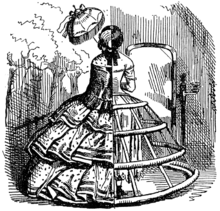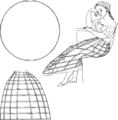- Crinoline
-
 Bustle cage crinoline, c. 1868, Victoria and Albert Museum.
Bustle cage crinoline, c. 1868, Victoria and Albert Museum.
 Cutaway view of a crinoline, Punch magazine, August 1856
Cutaway view of a crinoline, Punch magazine, August 1856
Crinoline was originally a stiff fabric with a weft of horse-hair and a warp of cotton or linen thread. The fabric first appeared around 1830, but by 1850 the word had come to mean a stiffened petticoat or rigid skirt-shaped structure of steel designed to support the skirts of a woman’s dress into the required shape. In form and function it is very similar to the earlier farthingale.
Contents
Etymology
The name crinoline was invented by one of the fabric's manufacturers, who combined the Latin words crinis (meaning hair) and lin (meaning flax). An alternative origin for the word is sometimes given: the combination of the French words crin (specifically meaning horse-hair) and lin (again, meaning flax).
History
The crinoline was not the first accessory designed to support the wearer's skirts in a fashionable shape; the farthingale in its various forms was worn from the late fifteenth century through the early seventeenth century, and panniers throughout the eighteenth century. Many of these were formal and elaborate styles, often worn at royal courts and by mid to higher levels of society.
By mid-1780, England had supplanted France as influential fashion house in the Western world, exchanging light and elaborate style for a more plain, utilitarian mode of fashion. France and most of western Europe came to adopt this standard, particularly after the French Revolution, when French fashion turned against the styles favored by royalty, the court, and the aristocracy.
Under the prevailing neoclassical influence, women’s fashions slowly underwent a consistent transformation to assimilate the simple style based on the simple draped garments of Ancient Greece and the togas of ancient Rome. Skirts became straighter and more slender, worn with fewer and fewer — if any — petticoats. As a result, the eighteenth-century pannier became extinct for all but the most formal of functions.
The silhouette did not remain this way for long and skirt hems began to widen to give a more conical shape. By the 1810s, gores began to be used in skirts again, and skirts grew wider in the 1820s. The width of these skirts was sometimes supported by a small bustle. These were not always sufficient, and extra petticoats were worn to help.
The first 'crinolines' were petticoats starched for extra stiffness, made out of the new crinoline fabric. They often had ruffles to support the skirts to the desired width. However, these fabrics were not stiff enough to support their own weight, which tended to collapse the petticoats out of shape. Extra rigidity was added to petticoats through rings of cord or braid running around the hem. By the 1830s, women had started to wear petticoats with hoops of whalebone or cane inside the hem.
The first hoop skirt in the US is from 1846, patent number 4,584 of David Hough, Jr. In 1858, IRJ Mann's US patent number 20,681 was the first latticework of strings and hoops.
In 1858, the American W.S. Thomson greatly facilitated the development of the cage crinoline by developing an eyelet fastener to connect the steel crinoline hoops with the vertical tapes descending from a band around the wearer’s waist. The invention was patented in the United States (patent US21581), France (patent FR41193) and Britain (patent GB1204/1859). This facilitated the fashionable silhouette's development from a cone shape to a dome. It was not an entirely original idea; Thompson was probably inspired by the open cage or frame style of farthingales and panniers.
The cage crinoline was adopted with enthusiasm: the numerous petticoats, even the stiffened or hooped ones, were heavy, bulky and generally uncomfortable. It was light — it only required one or two petticoats worn over the top to prevent the steel bands appearing as ridges in the skirt — and freed the wearer's legs from tangling petticoats.
Unlike the farthingale and panniers, the crinoline was worn by women of every social class. The wider circulation of magazines and newspapers spread news of the new fashion, also fueling desire for it, and mass production made it affordable.
Decline
 Two English crinolettes, 1872–75, Los Angeles County Museum of Art, M.2007.211.387 and 388.
Two English crinolettes, 1872–75, Los Angeles County Museum of Art, M.2007.211.387 and 388.
The crinoline had grown to its maximum dimensions by 1860. However, as the fashionable silhouette never remains the same for long, the huge skirts began to fall from favour. Around 1864, the shape of the crinoline began to change. Rather than being dome-shaped, the front and sides began to contract, leaving volume only at the back. The kind of crinoline that supported this style was sometimes known as a crinolette. The cage structure was still attached around the waist and extended down to the ground, but only extended down the back of the wearer’s legs. The crinolette itself was quickly superseded by the bustle, which was sufficient for supporting the drapery and train at the back of the skirt.
Problems
The crinoline was the subject of much ridicule and satire,[1] particularly in Punch magazine. Dress reformers did not like it either — they seized upon the cage aspect of the crinoline and claimed that it effectively imprisoned women. Given that the crinoline did eventually have a maximum diameter of up to 180 centimetres (six feet),[2] it is easy to imagine difficulties in getting through doors, in and out of carriages, and the general problems of moving in such a large structure. However, while the crinoline needed to have a degree of rigidity, it also had a degree of flexibility. A particular kind of steel, known as spring steel or watch-spring steel, enabled the hoops to be temporarily pressed out of shape.
The second problem was the potential impropriety of the crinoline. Its lightness was a curse as well as a blessing, as a gust of wind or a knock could set it swinging and reveal the wearer's legs. Even worse, if she tripped or was knocked over, the crinoline would hold her skirts up.
The third problem was the pressure, but a tight, stiff corset spread the pressure.
Sitting down could be a problem if the wearer failed to spread her skirts out properly as the entire hoop contraption would fly up in her face. This embarrassing but humorous tendency is often depicted in comedies of the era.
The greatest problem with the crinoline, though, was that in some situations it was dangerous — because of its size, the wearer was often not aware of where its edges were. It was only inconvenient and annoying when a maid’s crinoline knocked a vase off a table or upset a cup, but for factory girls, there was the risk of crinolines getting caught in machinery and dragging them to be mutilated or crushed to death[citation needed]. In 1857 the Paris correspondent of the New York Times reported a non-fatal accident to two “elegantly dressed” young women whose clothes caught fire in the street. It was believed that a lighted cigar had rolled under the dress of one as she sat at a cafe but ‘the balloon-like form of her skirts and the confined air’ delayed conflagration till she began to walk outside, when her skirts abruptly ignited. Her friend, rushing to her aid, also caught fire. Passers-by helped them and neither was seriously hurt. New York Times, 27 July 1857</ref>[3]
However there is one instance of a crinoline possibly saving a life, in the case of Sarah Ann Henley who jumped off the Clifton Suspension Bridge, Bristol in 1885 after a lover's quarrel, but survived the a fall of almost 75 metres (246 ft) because her skirts supposedly acted like a parachute and slowed her descent.[4] Although it is debated if the skirt actually saved Ms. Henley from the fall, the story has nevertheless become a local Bristol legend.
Current status
Crinolines are still worn today. They are usually part of a formal outfit, such as an evening gown or a wedding dress. The volume of the skirt is not as great as during the Victorian era, so modern crinolines are most often constructed of several layers of stiff net, with flounces to extend the skirt. If there is a hoop in the crinoline, it will probably be made of plastic or nylon, which are low in cost, lightweight and flexible, or steel.
With the recent trend towards lavish weddings and grandiose bridal attire, the crinoline has started making a comeback. For her first solo collection, fashion designer Vivienne Westwood looked to the crinoline for inspiration. The collection, titled Mini Crini, featured shorter crinoline skirts with more flexible plastic hoops.
Gallery
-
Bustle cage crinoline, England, 1862–70, LACMA M.2007.211.386
See also
- Bustle
- Farthingale
- Hoop skirt
- Panniers
- Petticoat
- 1850s in fashion
- 1860s in fashion
- Church of the Company Fire
Notes
- ^ Elizabeth Gaskell wrote a short story describing the first arrival, in 1856, of a fashionable French crinoline to a little English provincial town: it is mistaken for a parrot cage. [1] Gaskell, E: 'The Cage at Cranford', (1863)
- ^ Remains of a crinoline implicated in the death by fire of a 16 year old girl in 1863 were shown to the coroner's jury: 'One of the steel hoops measured three yards'. The Times, Saturday, Nov 14, 1863; pg. 5; Issue 24716; col D
- ^ In 1863 The Times reported the inquest on Margaret Davey, 14, a servant, whose dress “which was distended by a crinoline” caught fire while she was working. The jury returned a verdict of ‘Accidental death by fire, caused through crinoline’. The Deputy-Coroner remarked on the youth of many crinoline-wearers adding that he was ‘astonished to think that the mortality from such a fashion was not brought more conspicuously under the notice of the Registrar-General.' The Times, Friday, Feb 13, 1863; pg. 9; Issue 24481; col F. Nevertheless identical accidents caused the deaths of two other 16 year-old servants, in 1863 (The Times, Saturday, Nov 14, 1863; pg. 5; Issue 24716; col D) and 1867(The Times, Wednesday, Jan 23, 1867; pg. 4; Issue 25715; col D)
- ^ Chenery, T., ed (May 9, 1885). "LEAP FROM CLIFTON SUSPENSION BRIDGE". The Times (London, UK: Times Newspapers Ltd.) (31442): pg. 9, col F. ISSN 0140-0460. OCLC 145340223.
References
- Costume in Detail 1730 - 1930, Nancy Bradfield (ISBN 1-85882-038-3)
- Handbook of Nineteenth Century Costume, C. Willett Cunnington and Phillis Cunnington (ISBN 0-571-04703-3)
- Fashion in Underwear, Elizabeth Ewing (ISBN 0-7134-0857-X)
- Victorians Unbuttoned, Sarah Levitt (ISBN 0-04-391013-0)
- Corsets and Crinolines, Norah Waugh (ISBN 0-7134-5699-X)
External links
- "Corsets and Crinoline". Fashion, Jewellery & Accessories. Victoria and Albert Museum. http://www.vam.ac.uk/content/articles/c/corsets-and-crinolines-in-victorian-fashion/. Retrieved 2007-08-12.
Lingerie Upper torso Bandeau · Cupless bra · Male bra · Nursing bra · Push-up bra · Sports bra · Training bra · Underwire braOther
Lower torso Full torso Hosiery Historical Chemise · Basque · Bustle · Crinoline · Farthingale · Hoop skirt · Liberty bodice · Pannier · Pantalettes · Petticoat · Pettipants · Waist cincher · YếmAccessories Brands Aerie · Agent Provocateur · American Apparel · Baby Phat · Bali · Berlei · Bruno Banani · Calvin Klein · Chantelle · DKNY · Formfit · Frederick's of Hollywood · Fruit of the Loom · Gerbe · Gilly Hicks · Hanes · HerRoom · Intimissimi · Intimo Lingerie · Jockey · Jolidon · La Senza · Maidenform · No Nonsense · Olga Intimates · Passport Panties · Peach John · Playtex · Pretty Polly · Trashy Lingerie · Triumph International · Ultimo · Underalls · Valisere · Vassarette · Victoria's Secret · Wacoal · Warner's · Wolford · Wonderbra · XTG Extreme GameCategories:- Lingerie
- Skirts
- History of clothing (Western fashion)
- Formalwear
- Woven fabrics
- French loanwords
- History of fashion
Wikimedia Foundation. 2010.











